Benefits of integrated care for mental health and addiction
Transforming Recovery: How Integrated Care Enhances Mental Health and Addiction Treatment

The Growing Need for Integrated Care
With nearly half of individuals facing substance use disorders also battling mental health conditions, traditional separate treatments no longer suffice. This article explores how integrated care models unite mental health and addiction services, offering comprehensive, patient-centered approaches that improve outcomes, reduce relapse, and promote sustained recovery.
Understanding Integrated Care for Mental Health and Addiction
What is Integrated Care?
Integrated care is a holistic approach that simultaneously addresses mental health and substance use disorders within a single, coordinated treatment plan. It blends physical healthcare with behavioral health services to treat patients as whole individuals. Rather than treating mental health and addiction separately, integrated care combines these efforts, recognizing the interconnection between mental and physical wellbeing.
How Does Integrated Care Address Co-Occurring Disorders?
Nearly half of individuals with substance use disorders also experience mental health conditions such as depression, anxiety, bipolar disorder, or PTSD. Integrated care models provide comprehensive evaluations and coordinated treatment tailored to these complex, co-occurring disorders.
These models often include medication-assisted treatment, various therapeutic interventions like cognitive-behavioral therapy, group and family therapy, and structured transitions across levels of care such as Partial Hospitalization Programs (PHP), Intensive Outpatient Programs (IOP), and ongoing outpatient services. This approach reduces relapse risks and improves long-term recovery by addressing all facets of a patient’s health simultaneously.
What Are the Benefits of Integrated Treatment Plans?
Integrated care offers numerous advantages:
- Improved outcomes: Simultaneous treatment leads to reduced substance use, better mental health symptoms, and decreased hospitalizations.
- Reduced stigma: Treating behavioral health as part of regular medical care normalizes these issues, encouraging patients to seek help.
- Better coordination: Streamlined communication among healthcare providers promotes holistic, tailored care plans.
- Patient-centered approach: Treatment is customized to individual needs, driving engagement and satisfaction.
- Cost efficiency: Preventing hospital readmissions and emergencies lowers overall healthcare expenses.
What types of comprehensive treatment services are available for substance abuse and mental health issues?
Comprehensive services incorporate integrated strategies like medically supervised detox, counseling, behavioral therapies such as motivational interviewing, and medication-assisted treatment. These services are delivered across various settings from inpatient hospitals to outpatient clinics, ensuring alignment with patient severity and needs.
Specialized programs serve unique populations including pregnant women, adolescents, and minorities, while family-based interventions strengthen support systems. Integration also includes linkage among primary care, mental health, and substance use services, improving access, adherence, and long-term success.
Together, these components form a continuum of care fostering sustainable recovery and healthier lives.
The Prevalence and Complexity of Co-Occurring Disorders
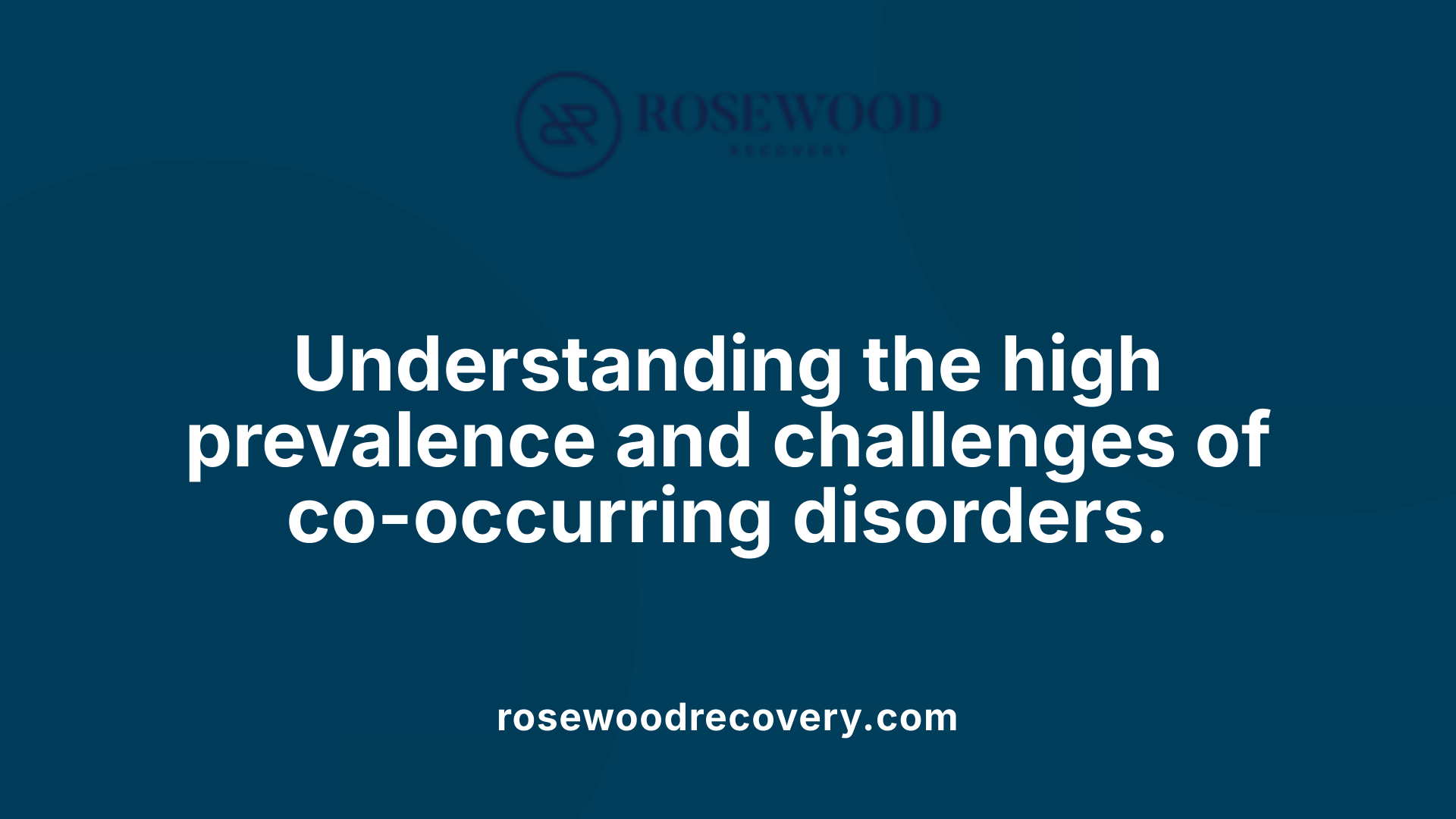
How common are co-occurring mental health and substance use disorders?
Nearly half of individuals diagnosed with a substance use disorder also face a mental health condition. This significant overlap, reported by SAMHSA, highlights the frequency with which these disorders coexist in the population, underscoring the importance of addressing both issues in treatment.
What are some typical combinations of co-occurring disorders?
Common pairings include:
- Depression coupled with alcohol use
- Anxiety alongside stimulant use
- Bipolar disorder and substance abuse
- PTSD paired with opioid dependence These combinations create intricate challenges as the symptoms of each can exacerbate the other, forming a complex cycle that complicates treatment efforts.
Why is managing co-occurring disorders challenging?
The interplay between mental health and substance use disorders complicates diagnosis and therapy. Patients often experience overlapping symptoms, which may mask one condition or amplify the other. This cycle increases risk for relapse and poses difficulties in selecting effective interventions. The complexity demands integrated treatment approaches that simultaneously tackle both disorders to improve outcomes and reduce the chance of recurrence.
Why Treating Co-Occurring Disorders Simultaneously is Essential
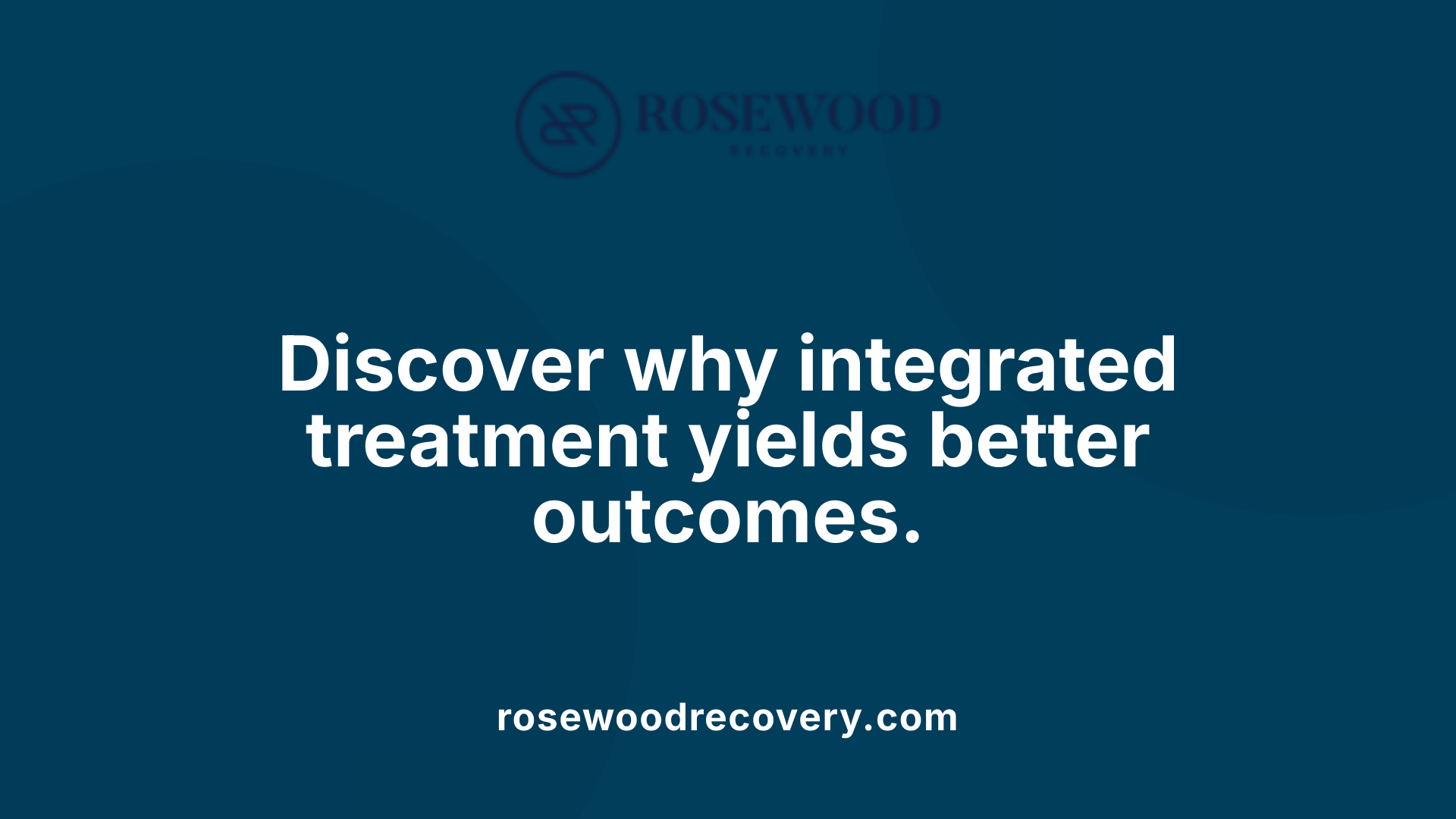
Effectiveness of integrated treatment versus separate treatments
Nearly half of individuals with substance use disorders also experience mental health conditions, making co-occurring disorders common and complex. Integrated treatment, which addresses both mental health and substance use simultaneously, has proven more effective than treating each condition separately. Unlike isolated treatments, integrated approaches provide a comprehensive plan that considers the interplay between psychiatric symptoms and addiction, improving psychiatric functioning and reducing substance use more effectively.
Impact on relapse and long-term recovery
Treating co-occurring disorders in an integrated fashion dramatically decreases relapse rates by addressing the underlying mental health conditions fueling substance abuse. Long-term outcomes such as sustained abstinence, improved psychiatric symptoms, housing stability, and reduced hospitalizations are better supported when both disorders are managed concurrently. Programs that combine medication-assisted treatment, therapeutic interventions, and continued care options (like outpatient and intensive outpatient programs) enable patients to transition smoothly through stages of recovery and maintain lasting wellness.
Role of a coordinated treatment plan
A single, coordinated treatment plan minimizes fragmentation of care by bringing together multidisciplinary teams including therapists, psychiatrists, and primary care providers. This plan incorporates medication management, evidence-based psychotherapy, family therapy, and routine screenings for both disorders to ensure comprehensive evaluation and ongoing monitoring. Such coordination enhances communication among providers, reduces stigma, and tailors treatment to the individual’s unique needs, empowering patients and improving adherence and satisfaction.
What role do mental health services play in the treatment of substance abuse and addiction?
Mental health services are vital in treating substance abuse because they diagnose and manage the high prevalence of co-occurring psychiatric conditions. By integrating mental health care into substance abuse treatment—via individual and group therapy, medication, and family involvement—the approach addresses both psychological and addiction issues. This comprehensive care reduces relapse risk, supports social reintegration, and is increasingly accessible through models like Collaborative Care and Primary Care Behavioral Health, which bring behavioral health into primary settings. Overall, mental health services provide personalized, effective intervention that advances long-term recovery and quality of life.
Core Components of Effective Integrated Care Models
Collaborative Care Model (CoCM)
The Collaborative Care Model is an evidence-based approach that integrates a multidisciplinary team into primary care settings. This team typically includes a behavioral health care manager and a consulting psychiatrist. CoCM supports population-based care, measurement-based care, care management, psychiatric consultation, and brief evidence-based psychotherapy. It allows treatment within familiar primary care environments, reducing stigma and improving patient compliance. Studies show CoCM significantly improves mental and physical health outcomes, reduces emergency room visits by 54%, and inpatient psychiatric care by 49%. The model is highly scalable, with psychiatrists in this approach able to serve large patient populations efficiently.
Primary Care Behavioral Health (PCBH) Model
The PCBH model embeds behavioral health consultants directly in primary care clinics where they conduct assessments and brief interventions. This model enables a high throughput of patients and supports early identification and management of mental health and substance use disorders. By integrating behavioral health experts onsite, PCBH improves patient access to mental health services and fosters seamless coordination between providers, which is essential for comprehensive care.
Screening, Brief Intervention, and Referral to Treatment (SBIRT)
SBIRT is a model emphasizing universal screening for mental health and substance use issues within primary care, followed by brief intervention and, if necessary, referral for specialized treatment. This model plays a vital role in early detection and timely management, which can reduce the severity of disorders and prevent escalation. Oklahoma has successfully integrated SBIRT in clinics, complementing PCBH and CoCM efforts to expand access to behavioral health treatment.
Multidisciplinary Team Approach
At the heart of effective integrated care are multidisciplinary teams that include primary care providers, behavioral health specialists, psychiatrists, and often social workers or case managers. This team-based approach enables comprehensive evaluation and treatment planning that address both mental health and substance use simultaneously. Structured communication and shared responsibility among team members help in developing personalized care plans. Such collaboration fosters creativity in managing complex, chronic conditions and improves outcomes by addressing the whole person's needs.
Together, these components form a robust framework for integrated care that enhances treatment accessibility, effectiveness, and patient satisfaction while reducing relapse rates and healthcare costs.
Collaborative Care Model: Evidence and Impact
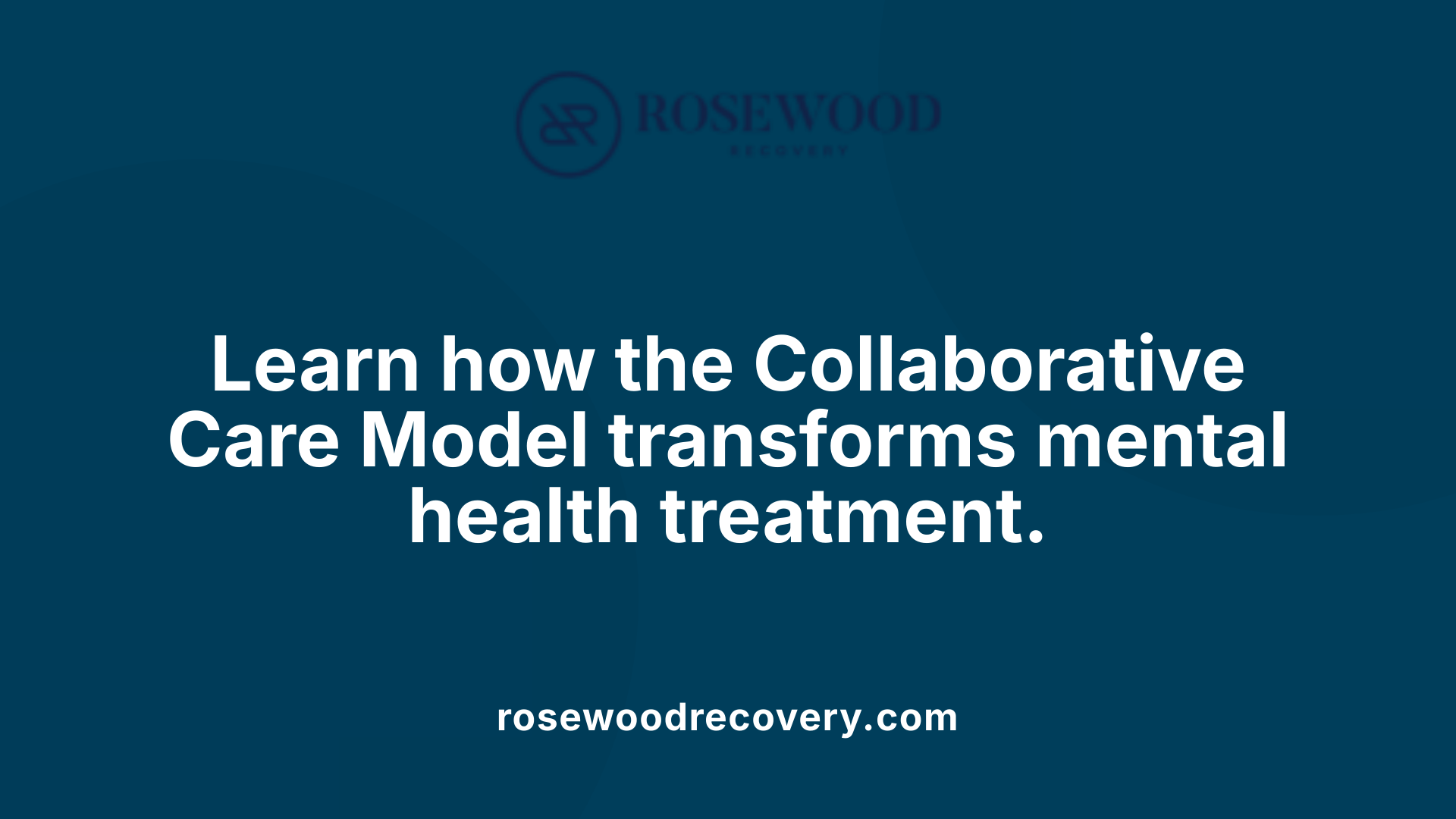
What is the Collaborative Care Model and what are its main components?
The Collaborative Care Model (CoCM) is an evidence-based approach designed to integrate behavioral health services into primary care settings. It emphasizes a team-based system that includes a primary care provider, a behavioral health care manager, and a consulting psychiatrist. The model operates using five core components: population-based care, measurement-based care (MBC), care management, psychiatric consultation, and brief evidence-based psychotherapy. These elements work in concert to provide comprehensive, personalized care for patients dealing with mental health and substance use disorders.
How does CoCM impact patient volume and treatment outcomes?
CoCM is notable for its scalability, enabling a single psychiatrist to manage care for approximately 226,800 patients over their career through teamwork and efficient delegation. This model improves access by reaching a larger patient population effectively within primary care frameworks. Studies consistently demonstrate that CoCM improves both mental and physical health outcomes across diverse groups—including women with perinatal depression, older adults, and individuals with substance abuse treatment needs. Patients benefit from reductions in symptoms, enhanced quality of life, and higher satisfaction with care.
What reductions in emergency and inpatient care have been observed under CoCM?
Implementation of the Collaborative Care Model has been associated with significant decreases in costly healthcare usage. Research shows a 54% reduction in emergency room visits and a 49% decrease in inpatient psychiatric care. This reduction highlights CoCM’s effectiveness in managing mental health and substance use disorders proactively, which prevents crises requiring urgent hospital-based care. Ultimately, this results in better patient outcomes and substantial healthcare cost savings.
Integrated Care Expands Access and Reduces Stigma
How do universal screenings in primary care enhance early identification?
Universal screenings in primary care settings have become crucial in the early detection of mental health and substance use disorders. By routinely incorporating tools like the PHQ-2 and PHQ-9, primary care providers can identify conditions such as depression and substance use early. This proactive approach not only enables timely intervention but also streamlines referrals to appropriate treatments, potentially reducing the severity of these illnesses over time.
How does integrated care normalize mental health and addiction treatment?
Integrated care models help normalize mental health and addiction treatment by embedding these services directly into general healthcare settings. When mental health screenings and treatments are offered alongside routine physical health exams—similar to measuring blood pressure—patients perceive these services as a normalized part of overall health. This integration significantly reduces stigma, encouraging more individuals to seek help without fear or shame.
In what ways does integrated care improve access, especially for underserved populations?
Integrated care dramatically improves access to behavioral health services by addressing traditional barriers such as provider shortages and fragmented care. Models like the Collaborative Care Model (CoCM) leverage multidisciplinary teams to extend mental health services effectively, impacting thousands of patients including underserved groups. Additionally, integrated systems enhance connections to social services and support networks, which are especially beneficial for low-income and uninsured patients. These improvements help lower rates of untreated mental health and substance use disorders and promote equitable health outcomes across communities.
Treatment Settings and Continuum of Care in Integrated Models
What are the Partial Hospitalization Program (PHP) and Intensive Outpatient Program (IOP)?
The Partial Hospitalization Program (PHP) and Intensive Outpatient Program (IOP) are structured treatment settings designed to support individuals with substance use disorders and co-occurring mental health conditions. PHP offers a high level of care where patients attend treatment sessions multiple hours per day but return home in the evenings, bridging the gap between inpatient hospitalization and outpatient care. IOP provides a slightly less intensive treatment, typically involving several days a week of therapy and support while allowing patients to maintain daily responsibilities like work or school.
These programs integrate therapies that address both addiction and mental health conditions simultaneously, including medication-assisted treatments and evidence-based psychotherapies. The design promotes safer transitions through various recovery stages and supports sustained sobriety and symptom management.
How is outpatient and continuing care integrated into treatment?
Outpatient and continuing care components form the backbone of long-term recovery in integrated care models. After intensive treatments like PHP or IOP, patients transition to outpatient therapy to maintain progress through individual counseling, group therapy, and medication management. Continuing care emphasizes relapse prevention and ongoing mental health support, recognizing that recovery is an extended process.
This stage-wise approach allows for tailored interventions matching a patient's evolving needs and helps sustain gains by offering flexibility and ongoing connection with multidisciplinary teams.
What role do stage-wise and multidisciplinary approaches play in these models?
Stage-wise treatment acknowledges that recovery unfolds in phases requiring different levels and types of care. Integrated programs implement comprehensive strategies combining motivational interviewing, cognitive-behavioral therapy, and family involvement, among other modalities, to address the complexity of co-occurring addictions and mental illnesses.
Multidisciplinary teams including psychiatrists, psychologists, addiction specialists, primary care providers, and social workers collaborate to create individualized treatment plans. This diversity fosters comprehensive care addressing biological, psychological, and social aspects of addiction and mental health challenges.
How do treatment programs address various forms of addiction beyond substance abuse?
Beyond substance use disorders, treatment programs incorporate targeted behavioral therapies such as contingency management and family-based interventions tailored for behavioral addictions like gambling or internet use disorders. Medication options (e.g., bupropion for nicotine dependence) complement therapy to manage cravings and withdrawal.
Furthermore, peer support groups and community resources play critical roles in fostering recovery. Integration of mental health care ensures that co-occurring disorders like depression or anxiety are simultaneously treated, preventing relapse and promoting holistic wellness.
| Treatment Level | Description | Importance in Integrated Care |
|---|---|---|
| Partial Hospitalization (PHP) | Structured daytime treatment with medical and therapeutic support | Provides intensive, coordinated care without full hospitalization |
| Intensive Outpatient (IOP) | Regular therapy sessions allowing daily life activities | Maintains treatment momentum with less intensity |
| Outpatient and Continuing Care | Long-term support through counseling and medication | Ensures sustained recovery and relapse prevention |
| Stage-wise Approaches | Tailoring treatments to recovery phases | Addresses evolving patient needs |
| Multidisciplinary Teams | Collaboration of varied health professionals | Facilitates comprehensive, holistic treatment |
Integration of Physical Health with Behavioral Health Care
Why Is It Important to Address Physical Health Alongside Mental Health and Addiction?
Addressing physical health issues together with mental health and addiction conditions is essential because these areas deeply influence each other. Individuals with mental illnesses often have higher rates of chronic physical conditions such as hypertension, diabetes, and heart disease. For example, depression has been linked to increased risks of diabetes, arthritis, cancer, and worsened outcomes in diseases such as hypertension and cancer.
When mental health problems and addictions are treated without considering physical health, poorer overall outcomes can result. Integrated care treats the whole person, coordinating mental health, addiction treatment, and physical healthcare simultaneously, which leads to more comprehensive and effective treatment.
How Does Integrated Care Improve Overall Health Outcomes?
By merging physical health services with behavioral and addiction care, integrated models help prevent duplication of services and reduce healthcare costs. These approaches improve adherence to medical treatments and appointments, and foster communication among healthcare providers. Integrated care models also normalize mental health and addiction treatment as part of general health care, reducing stigma.
Universal screenings in primary care settings enable earlier intervention, and care plans developed by multidisciplinary teams address the full spectrum of patient needs. Studies reveal that integrated care results in better mental well-being, reduced relapse rates, and improved management of chronic physical diseases when combined with behavioral health treatment.
Examples of Comorbid Physical Conditions in Integrated Care
- Diabetes and Depression: Depression negatively impacts diabetes management, but integrated treatment can improve both conditions simultaneously.
- Hypertension and Anxiety: Anxiety can exacerbate high blood pressure; combining care improves overall cardiovascular health.
- Arthritis and Substance Abuse: Pain and addiction often co-occur, requiring coordinated approaches to reduce substance misuse while managing physical pain.
By treating these co-occurring physical and behavioral health issues via integrated care, patients experience improved quality of life, fewer hospitalizations, and reduced healthcare utilization.
Cost-Effectiveness and Healthcare Utilization Benefits
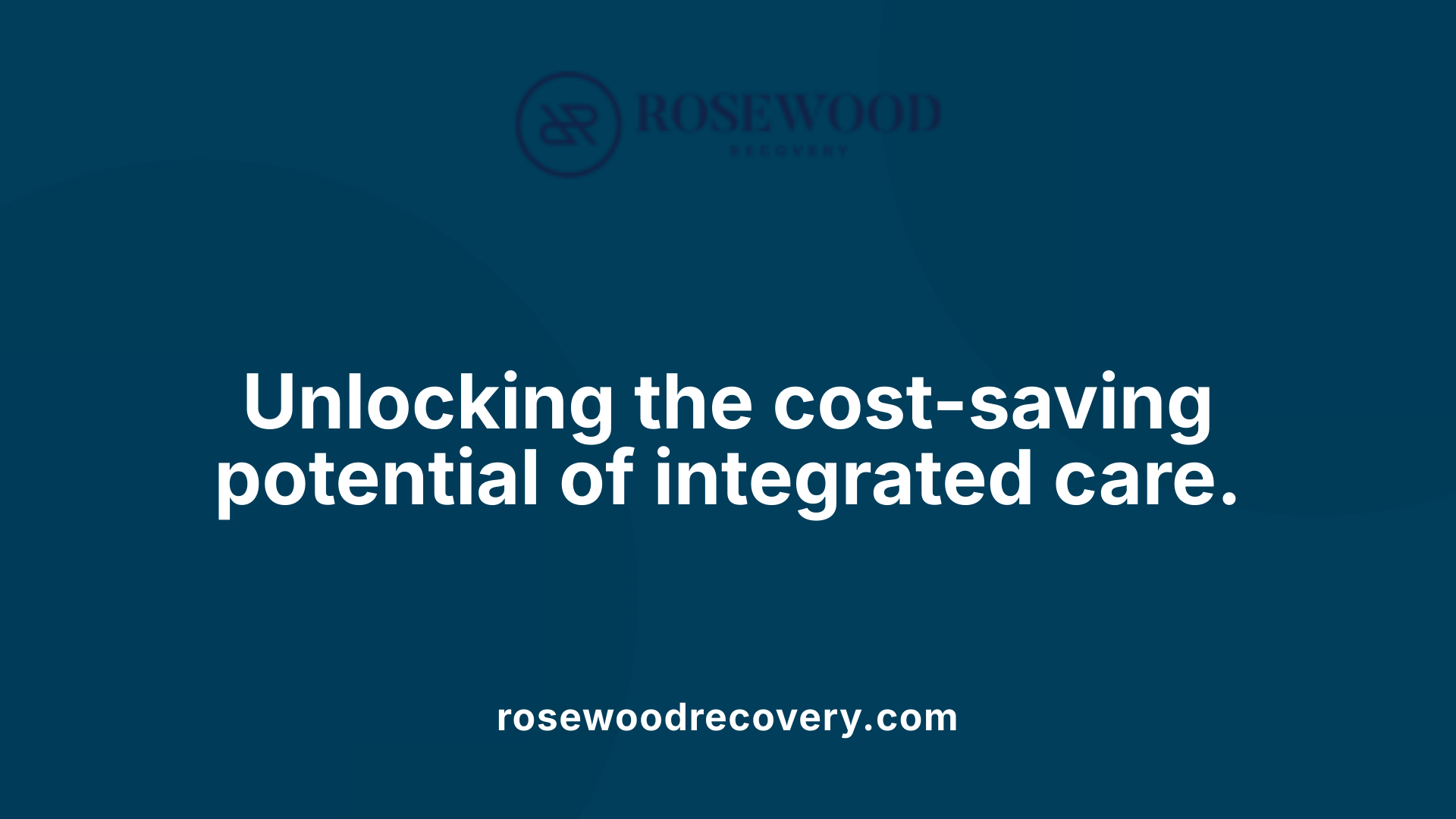
How Does Integrated Care Reduce Hospital Readmissions and Emergency Visits?
Integrated care models, such as the Collaborative Care Model (CoCM), significantly reduce the use of costly hospital and emergency services. Studies report a 54% decrease in emergency room visits and a 49% reduction in inpatient psychiatric care among patients receiving integrated care. This is because integrated care addresses both mental health and substance use disorders simultaneously, leading to better management of symptoms and fewer crises requiring hospitalization.
How Does Prevention and Early Intervention Lower Overall Healthcare Costs?
By promoting universal screenings and routine measurement-based care, integrated models enable early detection and treatment of mental health and substance use conditions. Early intervention helps prevent the escalation of disorders, reducing complications and the need for intensive and expensive treatments later. Moreover, treating mental illnesses and addictions in a coordinated way improves adherence to medical regimens and reduces costly hospital stays. Overall, this preventive approach lowers total healthcare spending.
What Efficiency Gains Are Achieved Through Integrated Multispecialty Collaboration?
Integrated care fosters teamwork among primary care providers, behavioral health specialists, psychiatrists, and other health professionals. This multidisciplinary collaboration streamlines communication and care coordination, eliminating service duplication. Shared patient information and joint treatment planning enhance effectiveness and reduce wasted resources. Integration also supports structured care transitions through options like Partial Hospitalization Programs (PHP), Intensive Outpatient Programs (IOP), and continuing outpatient care, resulting in sustainable recovery and efficient use of healthcare resources.
Enhanced Communication and Patient Satisfaction
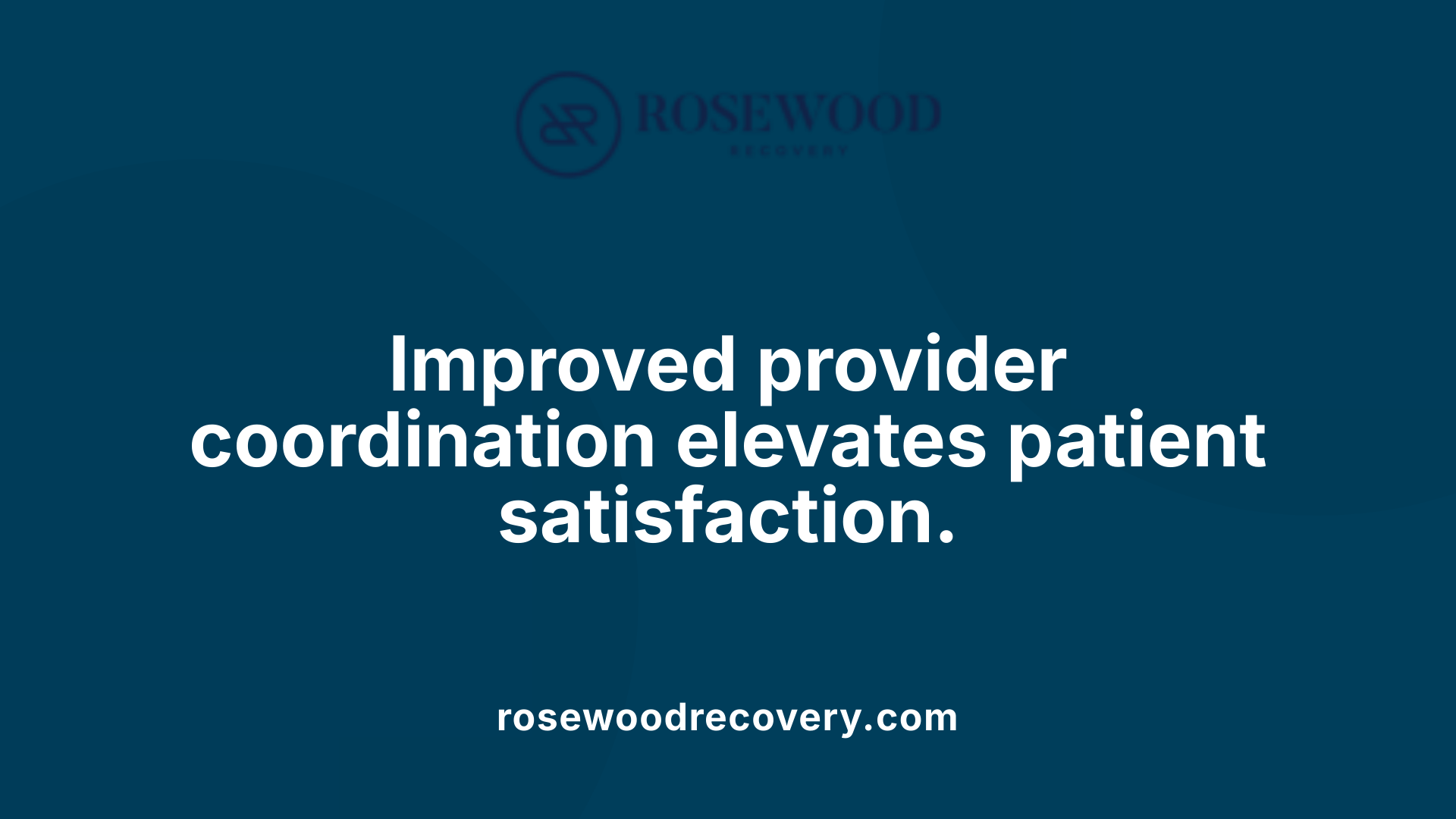
How does integrated care improve coordination among healthcare providers?
Integrated care fosters streamlined communication by bringing together mental health, substance use, and physical healthcare providers into coordinated teams. This collaboration enables shared patient information systems, facilitating real-time updates and consistent treatment planning. Providers meet regularly and communicate face-to-face more often, which reduces gaps and duplications in care.
What role do shared patient information systems play in integrated care?
Shared electronic health records and data platforms ensure that all members of a multidisciplinary team have access to the latest diagnostic, medication, and therapy information. This transparency improves clinical decision-making, timely interventions, and continuity of care, particularly vital for patients managing both mental health and addiction issues.
How does enhanced communication impact patient and provider satisfaction?
Both patients and providers report higher satisfaction in integrated care settings. Patients benefit from convenient coordinated appointments and a holistic approach that saves time and reduces stigma. Providers appreciate improved communication flow, comprehensive information, and collaborative problem-solving, all of which contribute to better health outcomes and workplace efficiency.
Overall, integrated care’s emphasis on communication creates a more cohesive treatment experience that supports patient engagement, reduces misunderstandings, and builds trust between patients and providers.
Overcoming Barriers to Integrated Care Implementation
What Are the Common Obstacles to Integrated Care?
Integrated care faces several challenges that hinder its widespread adoption. High workloads for healthcare providers often limit the time available for comprehensive behavioral health integration. Billing complexities and reimbursement issues create financial barriers, making it difficult for practices to sustain integrated services. Additionally, insufficient training leaves many providers unprepared to deliver or coordinate integrated mental health and substance use care effectively. Confidentiality concerns and stigma related to mental health and substance use disorders also act as significant deterrents, complicating service delivery.
How Are Policy Initiatives and Medicaid Reforms Supporting Integration?
Recent policy efforts have aimed to alleviate these barriers. Medicaid Health Homes and new billing codes have been introduced to facilitate better reimbursement for integrated behavioral health services in primary care settings. These reforms encourage healthcare systems to adopt coordinated care models by providing financial incentives and fostering system restructuring. Federal grants and policy initiatives support states like Oklahoma in expanding evidence-based models such as the Collaborative Care Model, enhancing access and quality of integrated behavioral health care.
What Role Do Advocacy and Education Play in Advancing Integrated Care?
Advocacy organizations actively work to remove barriers to integrated care by promoting policies that recognize behavioral health as a core component of overall health. Their efforts emphasize the inclusion of behavioral health in routine screenings, reimbursable services, and quality standards. Education is equally vital; training healthcare providers improves their readiness and confidence in delivering integrated care. Quality improvement initiatives and increased provider awareness can help overcome stigma and create a culture that supports comprehensive treatment for mental health and substance use disorders.
Together, these strategies—addressing systemic obstacles, leveraging supportive policies, and fostering advocacy and education—are essential to realizing the full benefits of integrated care, improving health outcomes, and reducing the societal burden of co-occurring mental health and substance use disorders.
The Future of Integrated Care: Collaborations Beyond Healthcare
How does integrated care extend beyond traditional healthcare sectors?
The future of integrated care envisions a broad cross-sector collaboration that extends far beyond healthcare settings alone. This approach involves integrating social services, public health initiatives, education systems, and law enforcement agencies into a unified framework aimed at improving mental health and addiction outcomes. By linking these diverse sectors, healthcare providers can address the complex social determinants affecting patients' wellbeing, such as housing instability, educational challenges, and community safety.
What role do social services and education play in advancing integrated care?
Social services contribute by providing critical support that tackles economic and environmental factors influencing mental health. Educational institutions, on the other hand, are vital for early identification and prevention strategies through curriculum adaptations and support services tailored to students' behavioral health needs. Collaborations with schools help normalize mental health care and facilitate timely interventions, reducing the likelihood of chronic conditions developing.
How does involving public health and law enforcement improve outcomes?
Public health agencies bring expertise in population health management and epidemiology, enabling better surveillance, prevention, and community outreach programs targeting behavioral health issues. Law enforcement partnerships are crucial for creating supportive responses to individuals with mental health and substance use disorders, particularly through diversion programs that connect people to appropriate care rather than incarceration, reducing stigma and improving long-term recovery prospects.
What emerging policy and systemic trends support these collaborations?
Current policy initiatives are increasingly encouraging integrated care models that support these cross-sector approaches. Federal and state programs, including Medicaid Health Homes and new reimbursement frameworks, promote comprehensive care coordination involving multiple sectors. Advocacy organizations persistently work to remove barriers to integration, ensuring behavioral health services are routinely included in screenings and quality care standards.
Why are these collaborations essential?
Mental health and addiction are deeply interwoven with social and environmental factors that no single sector can adequately address alone. Integrating care across sectors fosters more holistic interventions, minimizes gaps in service delivery, and enhances resource utilization. This systemic evolution promises not only better clinical outcomes but also improved social equity and reduced long-term healthcare costs by addressing root causes early and comprehensively.
Patients as Partners: The Essence of Patient-Centered Integrated Care
Tailoring Treatment Plans to Individual Needs
Integrated care focuses on treating patients as whole individuals by addressing physical, mental, and addiction-related health issues together. This approach emphasizes customizing treatment plans to fit each patient’s unique health challenges and personal circumstances. By doing so, care becomes more relevant and effective, ultimately improving recovery outcomes.
Empowering Patients and Involving Families
Patient-centered integrated care goes beyond clinical treatment to actively involve patients and their families in the recovery process. This inclusion empowers individuals to take an active role in managing their health, fostering greater engagement and adherence to treatment. Family participation also provides crucial support, improving the overall healing environment.
Holistic Focus on Well-Being and Recovery Journey
The integrated approach centers on holistic well-being by recognizing the interconnectedness of mental health, substance use, and physical conditions. It supports patients not just in symptom reduction but in rebuilding a meaningful life through comprehensive evaluations, group therapy, and tailored interventions. This comprehensive strategy nurtures sustained recovery and enhances quality of life.
Integrated Care: A Lifeline for Mental Health and Addiction Recovery
Integrated care represents a transformative approach to treating the intertwined challenges of mental health and addiction. By addressing the whole person—mind and body—within coordinated, multidisciplinary frameworks, it not only improves clinical outcomes but also reduces stigma, increases access, and makes treatment more affordable and sustainable. As healthcare systems evolve and embrace cross-sector partnerships, integrated care promises to be a vital lifeline helping millions achieve lasting recovery and well-being.
References
- The Benefits of Integrated Care for Co-Occurring Disorders
- Understanding integrated behavioral health care and the ...
- Why is Integrated Care Important? - Meridian HealthCare
- Collaborative mental health care: A narrative review - PMC
- The Benefits of Integrated Care: A Complete Approach to ...
- Integration of mental and general health care
- Integrated Treatment for Co-Occurring Disorders
- Benefits of Linking Primary Medical Care and Substance ...
More Articles
Recovery Begins Here
Click below to get in touch and schedule a consult call with our team to begin your journey towards happiness and freedom.
Rosewood Recovery does not discrimate against any person because of the race, color, religious creed, ancestry, age, sex, sexual orientation, gender identity, national origin, handicap or disability or the use of a guide or support animal because of the blindness, deafness or physical handicap.





